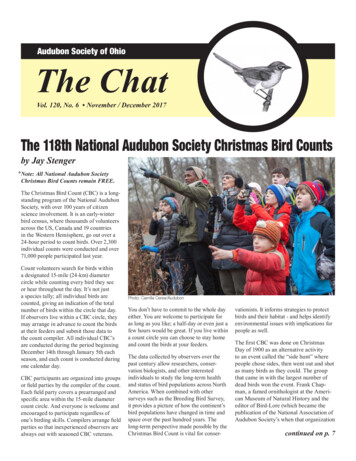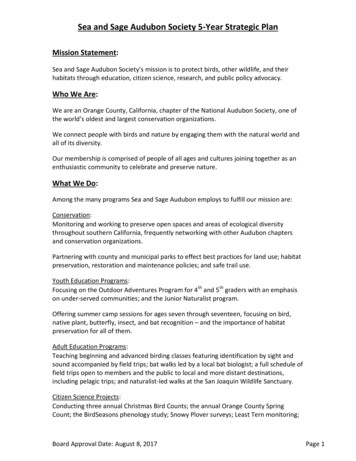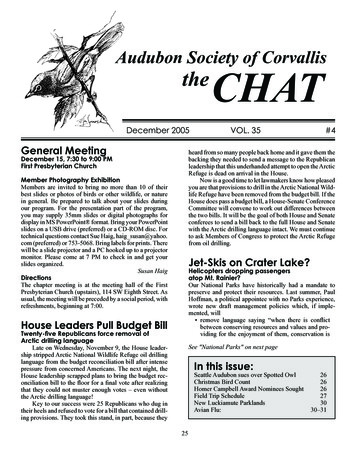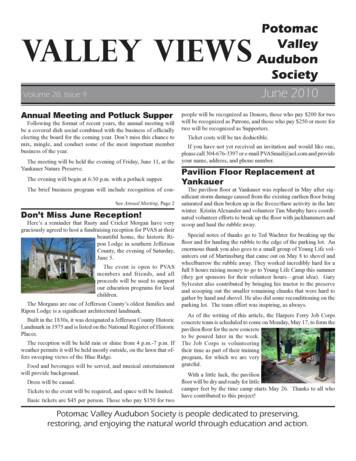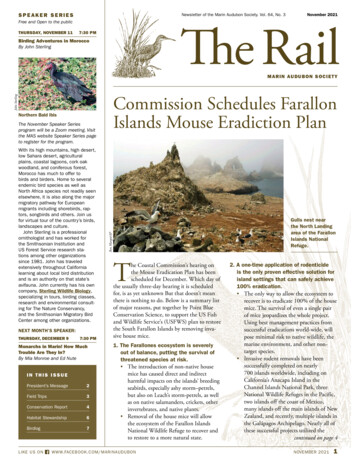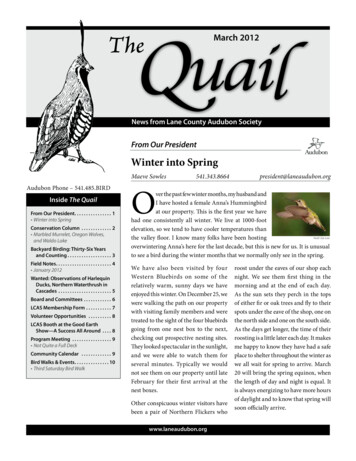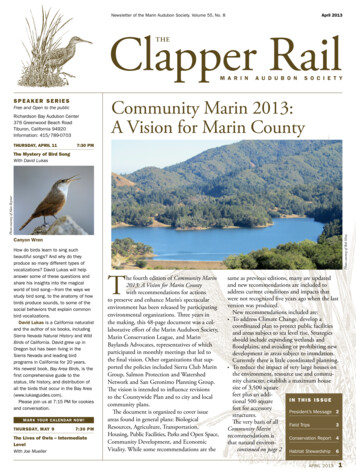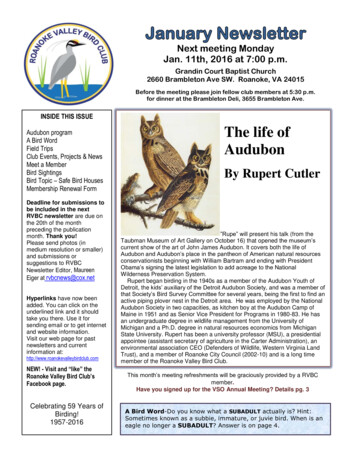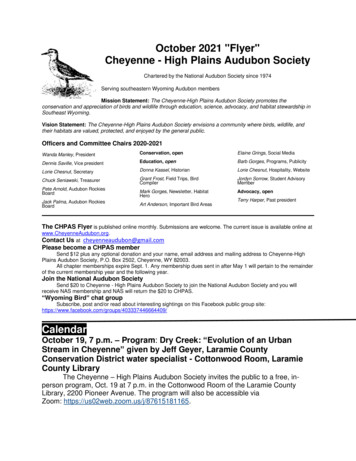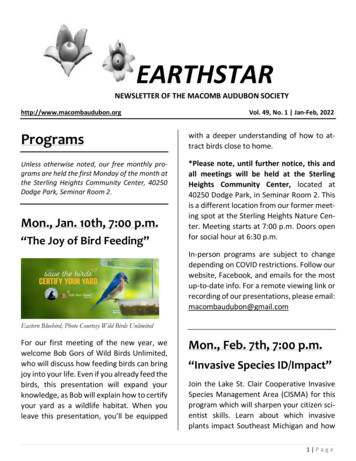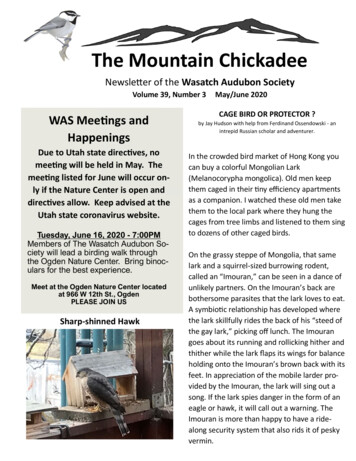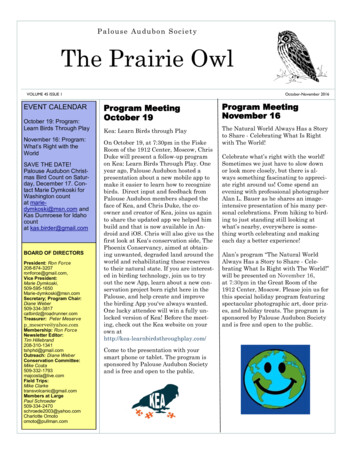
Transcription
Palouse Audubon SocietyThe Prairie OwlOctober-November 2016VOLUME 45 ISSUE 1EVENT CALENDAROctober 19: Program:Learn Birds Through PlayNovember 16: Program:What’s Right with theWorldSAVE THE DATE!Palouse Audubon Christmas Bird Count on Saturday, December 17. Contact Marie Dymkoski forWashington countat mariedymkoski@msn.com andKas Dumroese for Idahocountat kas.birder@gmail.comBOARD OF DIRECTORSPresident: Ron Force208-874-3207ronforce@gmail.com,Vice President:Marie ry; Program Chair:Diane Weber509-334-3817catbirdz@roadrunner.comTreasurer: Peter Meservep meserve@yahoo.comMembership: Ron ForceNewsletter Editor:Tim Hillebrand208-310-1341tshphd@gmail.comOutreach: Diane WeberConservation Committee:Mike Costa509-332-1793majcosta@live.comField Trips:Mike Clarketransvolcanic@gmail.comMembers at LargePaul te Omotoomoto@pullman.comProgram MeetingOctober 19Program MeetingNovember 16Kea: Learn Birds through PlayThe Natural World Always Has a Storyto Share - Celebrating What Is Rightwith The World!On October 19, at 7:30pm in the FiskeRoom of the 1912 Center, Moscow, ChrisDuke will present a follow-up programon Kea: Learn Birds Through Play. Oneyear ago, Palouse Audubon hosted apresentation about a new mobile app tomake it easier to learn how to recognizebirds. Direct input and feedback fromPalouse Audubon members shaped theface of Kea, and Chris Duke, the coowner and creator of Kea, joins us againto share the updated app we helped himbuild and that is now available in Android and iOS. Chris will also give us thefirst look at Kea's conservation side, ThePhoenix Conservancy, aimed at obtaining unwanted, degraded land around theworld and rehabilitating these reservesto their natural state. If you are interested in birding technology, join us to tryout the new App, learn about a new conservation project born right here in thePalouse, and help create and improvethe birding App you've always wanted.One lucky attendee will win a fully unlocked version of Kea! Before the meeting, check out the Kea website on yourown athttp://kea-learnbirdsthroughplay.com/Come to the presentation with yoursmart phone or tablet. The program issponsored by Palouse Audubon Societyand is free and open to the public.Celebrate what’s right with the world!Sometimes we just have to slow downor look more closely, but there is always something fascinating to appreciate right around us! Come spend anevening with professional photographerAlan L. Bauer as he shares an imageintensive presentation of his many personal celebrations. From hiking to birding to just standing still looking atwhat’s nearby, everywhere is something worth celebrating and makingeach day a better experience!Alan’s program “The Natural WorldAlways Has a Story to Share - Celebrating What Is Right with The World!”will be presented on November 16,at 7:30pm in the Great Room of the1912 Center, Moscow. Please join us forthis special holiday program featuringspectacular photographic art, door prizes, and holiday treats. The program issponsored by Palouse Audubon Societyand is free and open to the public.
V O LU M E 4 5 I S S U E 1T HE P R A I R I E O WLWing TipsPAGE 2From the PrezA bird’s eye takes up about 50 percent of its head; our eyes take upabout 5 percent of our head. To be comparable to a bird’s eyes, our eyeswould have to be the size of baseballs.The Penguin is the only bird that can swim, but not fly. It is also theonly bird that walks upright.Owls turn their heads almost 360 (a complete circle) but they cannotmove their eyes.Kiwis are blind, so they hunt by smell.Frigate birds sleep while flying. See this Audubon utm source engagement&utm medium email&utm campaign 2016-08-22-frigatebirdsAudubon Magazine ChangesATTENTION Palouse Audubon members who are also members of National Audubon Society: NAS is moving to a new publication schedulefor the Audubon magazine. Instead of six issues a year, each covering atwo-month period, the Audubon magazine will be published five timesa year on a seasonal basis: summer-fall-winter-spring plus one issue forthe Audubon photo contest. The new schedule began with the Summer2016 issue, and the fall issue should arrive mid-September. If you donot receive these issues, don't hesitate to call Audubon Member Services at 1-844-428-3826.Ron ForceEach year the Palouse AudubonSociety competitively awards a 500 grant to a graduate studentfrom Washington State Universityand the University of Idaho whoseresearch supports the conservationand natural history goals of the society. This year, we had no applicants from the UI, so two awardswere given to students from WSU.Lindsay Welfelt plans to use stable isotopes to inform black bearmanagement on the east and westslopes of the Cascades. Hair samples from bears will be analyzedusing stable isotopes to determinethe amount of human-provided foodin the bears’ diets so that wildlifemanagers can determine whetherfood attractants need to be reducedor other management practicesneed to be introduced.(continued on page 3)
V O LU M E 4 5 I S S U E 1T HE P R A I R I E O WLBIRD OF THE MONTH:The Cedar WaxwingBy Paul SchroederAs I look out the back window of my house in Pullmanat this time of year, I find it full of birds because I havea large Mountain Ash tree there which is now heavywith berries.The tree attracts robins, flickers and our Bird of theMonth, the Cedar Waxwing. Everyone enjoys seeingthese dapper little birds with their clean-cut lines andcocky crest. Occasionally they dominate the tree,though that role has recently been taken over by therobins. You can generally tell that they are present bytheir high-pitched call, which becomes almost a continuous sound when a large flock is present. The birds aregregarious and almost always found in flocks, both smalland large. In our area they are present year-round, although in the winter they are easier to find in the rivervalleys than on the Palouse. They rely on berries andother fruits during the winter, but in the summer theymay often be found “fly-catching”, much like the otherflycatchers. The name “waxwing” comes from the usually bright yellow, wax-like droplets which accumulatealong the edges of the secondary flight feathers.In the winter, the Cedar Waxwings are joined by a morenortherly species, the Bohemian Waxwing, which hassimilar behavior and feeding habits and is more likely tobe found in winter on the Palouse than the Cedar Waxwing. Bohemian Waxwings occur throughout more northerly regions of the Northern Hemisphere, from middleEurope (winter) to Scandinavia to Eastern Asia, breeding in Siberia and wintering as far south as Japan andKorea. There is also a Japanese Waxwing, which looks alot like a Bohemian and has a similar range, but only inthe Far East. I hope you have had the chance to watchthese lovely native birds this year.PAGE 3We Need YouThe Palouse Audubon Society is in need of interested folksto get involved with the local organization. Currently,there are open board of director and committee memberpositions available. The board of directors meet monthlyfrom September through May. Meetings usually last anhour to an hour and a half. Committees meet only whennecessary and most committees would benefit with somenew energy and ideas from members of PAS. Help fulfillthe mission of the Palouse Audubon Society: promote education, conservation, and the restoration of natural ecosystems focusing on birds, other wildlife, and their habitatsfor the benefit of humanity and the earth’s biological diversity. For more information, contact Marie Dymkoski, VicePresident at marie-dymkoski@msn.comFrom the Prez (continued)Korey Southerland will be updating a computermodel of the Palouse Basin aquifers using the latest data, and testing whether the model is understandable by general audiences, and if an understanding of the model leads people to participate indecisions about the aquifers and make changes intheir personal water use.Congratulations to these two students. We hope thatnext year we receive applications from the Universityof Idaho.Who Gives a Hoot?There are 216 species of owls. Although there isdisagreement, most bird taxonomists believethat the owls’ closest kin are the insect-eatingnightjars (also called nighthawks). The owl family is ancient — fossil owls are found in depositsmore than 50 million years old. In Idaho, fossilowls related to modern Screech-owls, Longeared owls, and Burrowing owls have been unearthed in the Hagerman fossil beds (3.5 million years BP). Owls found in Idaho include:Barn Owl, Barred Owl, Boreal Owl. BurrowingOwl. Flammulated Owl. Great Gray Owl. GreatHorned Owl, Long-eared Owl, Northern HawkOwl, Northern Pygmy Owl. Northern Saw-whetOwl, Short-Eared Owl, Snowy Owl, and Western Screech OwlA group of owls is called a parliament.OiTt1tTbsct
VOLUME 45 ISSUE 1THE PRAIRIE OWLPAGE 4Presenting the 2016 PAS Photo Contest ResultsThis photo contest was held as a fun event to increase the awareness of the presence and involvement of PASand to encourage appreciation of the environment, wildlife, nature, conservation, ecosystem, and sustainability.The contest provided an opportunity to use photographic skills to capture experiences and impressions of natureand present them in an artistic interpretation that can be appreciated by all! Hopefully, it also served to informthe public of the possibilities available for becoming actively involved in preserving the beauty of nature and oursurroundings. The photo contest is a vehicle that contributes to PAS public awareness and activities by providingan interactive venue for participants. This year the contest was open to all amateur photographers with no regional limitations. The three categories included birds, other wildlife, and other nature. A maximum of five entries were allowed to be submitted per participant. Photos were judged on technical merit, composition, creativity, and visual impact. Awards and prizes of 60 and 40 were presented to the first and second place winners,respectively, in each of the three categories.Summary of the 2016 Photo ContestA total of 20 participants submitted 82 entries from a variety of locations including Yellowstone, Potlatch,Lewiston, Clarkston, Viola, Moscow, Troy, Pullman, California, Indiana, Florida, Texas, Oregon, Illinois, Montana, Kenya, and Tanzania. The entries included 55 Bird, 12 Other Wildlife, and 15 Other Nature photos. Winning photos were selected by our panel of three judges. Awards will be presented at the October 19 programmeeting.THE WINNING PHOTOS:Continued on page 5
V O LU M E 4 5 I S S U E 1T HE P R A I R I E O WLPhoto Contest ContinuedAdditional entries can be viewed in greater detail under the “Photos” tab of the Palouse AudubonWebsite on the 2016 Photo Contest Page. We would like to express our appreciation to all who submitted their excellent photos for the contest. Stay tuned for an announcement informing when thenext photo contest will be held. And congratulations to the winners.Donors 2015-16Last year the following members gave extra to support the work of the society. Our thanks tothem for their generosity.Elise J AugensteinSteve & Anna BanksJudy BrownSharon Cabeen & David WherryCheryl ClancyMary Lou DeyoValerie DrownSid & Renée EderDonna EricksonMary FauciLauren FinsSusan FirorDoug & Pat FlansburgJoan FolwellRon ForceBruce & Lavon FrazierJim & Emily FredenburgSally FredericksTerry & Christine GrayDonna HansonSharon A HaydenJuliette M. HayesTrisch HeekinAndrew & Jeri HudakRobert & Janice InghramHarry JagemanSue A JohnsonInez B. KalinJan KellerRoger KorusAlice & John KramerMartha & Jack McIverDan McLaughlinElinor MichelConstance MillerJanet & George MountPaul MunetaBarbara NakataSteve & Linda NortonBo OssingerThomas R. PartingtonDiane PettitLarry PulleyPatricia RathmannJames Reece & Pat HineMarv ReedLouise RegelinGlen & Mary Sanchez LanierPaul SchroederNed & Carole SchroederDonna ShanamanJim SienkiewiczMeade A SnoddyJim & Mary Anne StormsBrian & Anne SumptionSteve & Chris TalbottCatherine TempleSarah C WalkerRichard & Barbara WellsCathryn WillmesJohn WolffGerry WrightCarolyn J WyattSharon YountSusan ZenierPAGE 5
PALOUSE AUDUBON SOCIETYPalouse AudubonPrimaryBusiness AddressSocietyYourBoxPOAddress3606 Line 2Your AddressMoscowID 83843-1914Line 3Your Address Line 4Get to know our local owlsGive a Hoot. Go Owling.The mission of the. Palouse AudubonSociety is to promote education,conservation, and the restoration ofnatural ecosystems--focusing onbirds, other wildlife, and theirhabitats--for the benefit of humanityand the Earth's biological diversityWe’re on the Web:www.palouseaudubon.organd on FacebookMEMBERSHIPPalouse Audubon Society (PAS), PO Box 3606, Moscow ID83843-1914, is a chapter of the National Audubon Society (NAS)with its own dues. New NAS members in our chapter area receiveone year’s free membership in PAS, along with the chapter newsletter and other benefits of membership.PAS dues of 15 are payable in September. Members may receive the chapter newsletter, The Prairie Owl, either by mail orby email notification of its posting on the chapter’s website. Members are encouraged to read the newsletter online to save printingand postage expenses. PAS members who have not renewed andNAS members who have not paid dues after one year of membership are removed from the newsletter distribution list on December 31st.General membership meetings are held at the 1912 Building,FISKE ROOM, 3rd and Adams St, Moscow ID, at 7:30 p.m. on thethird Wednesday of each month, September through May. Theboard of directors meets at the 1912 Center at 7:30 p.m. on thefirst Tuesday of each month.The Prairie Owl is published every other month, Augustthrough April. Material for the Owl should be sent to the editor,Tim Hillebrand, 857 Orchard Ave., Moscow ID 83843, 805-5189612, tshphd@gmail.com by the 20th of the month. Subscriptionproblems should be addressed to the membership chair, RonForce, PO Box 3606, Moscow ID 83843-1914, 208-874-3207, ronforce@gmail.com. Visit the Palouse Audubon Society website athttp://www.palouseaudubon.org/ or find us on Facebook.Audubon Strategic Plan 20162020“If Audubon truly lived up to its potential, howmuch good could we do?” That’s the question ournational leadership asks, given the very effectivelocal leadership of 23 state Audubon offices andhundreds of local chapters. If you would like todownload a copy of National Audubon’s neweststrategic plan, you can do so tegic plan 2016-2020 final.pdf
tional Audubon Society: NAS is moving to a new publication schedule for the Audubon magazine. Instead of six issues a year, each covering a two-month period, the Audubon magazine will be published five times a year on a seasonal basis: summer-fall-winter-spring plus one issue for the Audubon
